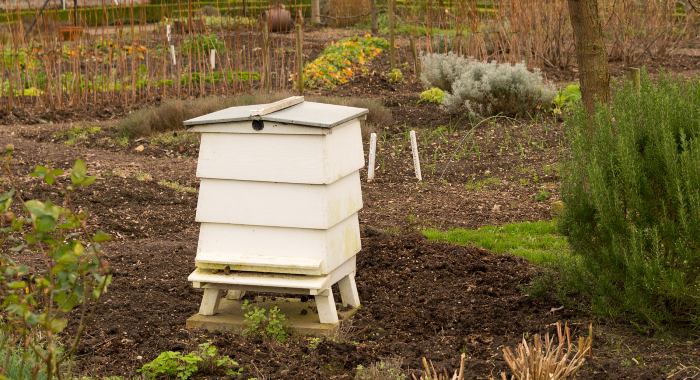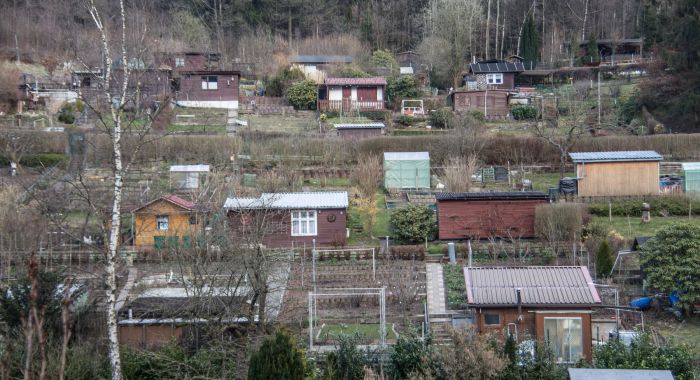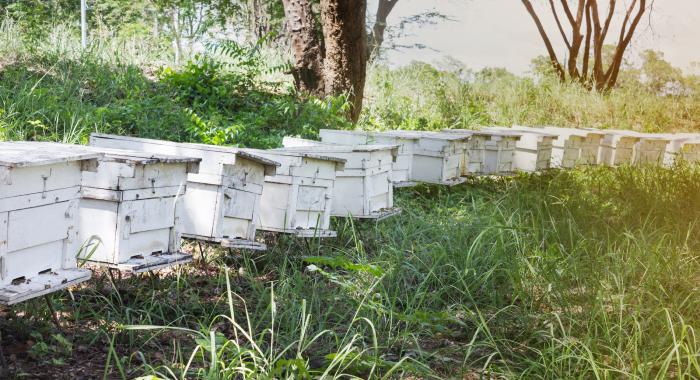One thing that many people ask when they’re first considering beekeeping is ‘can you keep bees on an allotment?’.
It’s a big question and this guide will help you with understanding the answers.
Bees are vital pollinators and therefore vital to entire ecosystems. And with the impact of man-made environmental destruction now taking effect, it’s more important than ever before that beekeepers are able to step up and plug the gaps.
Beekeeping can boost pollination, aid biodiversity and help sustain a healthy bee population while wild bee populations are sadly declining.
With all of that in mind, let’s take a closer look at what’s involved in keeping bees on an allotment, whether it’s the right thing to do and some precautions to keep in mind.
The Rise In Popularity Of Beekeeping
Beekeeping is definitely becoming more and more popular as people start to realize the benefits that come with it. For many, it’s a new hobby and something interesting and exciting.
It gives them the chance to interact with nature and do something positive in a way that they never have before. That’s why it’s not surprising that its popularity is really taking off right now.
If you are getting started in beekeeping, you’ll need to make sure you get the right equipment.
Investing in a good beehive and all of the other safety equipment will be vital. On top of that, you need to do your research and know the types of bees you’re buying and what you can expect from them.
Different species will present different challenges for you as a beekeeper.
As long as you’re going about this in the right way and you’re doing your best to put the health of your bees first, you won’t go far wrong. When you’re new to something like this, you’ll probably make mistakes to begin with but what matters most is how you respond to those situations and improve.
It’s also important to mention that taking up beekeeping and buying bees for your hive is a commitment.
It’s something that you should understand before you get into it because you don’t want to drop that commitment and let your bees suffer just because you didn’t really understand what you were getting into.
Can You Keep Bees On An Allotment?

This is the question that’s most important here, and the simple question is yes, most of the time.
You’ll find that it’s usually okay for you to keep your bees on an allotment that you’re renting from the local council. However, you will need to make sure that you check the rules set by your particular local authority before taking any action and installing your new beehive.
We’re going to cover the importance of following the rules below, as well as the rules you can expect.
But the only way you can really know for sure what you’re going to need to do and what the specific rules are in your area is to ask your local council. They should be more than happy to give you an answer to the question.
Following The Rules
It’s important that the correct rules are always followed if you are going to set up a beehive on your allotment. The first step is always to check what the local authority rules are in your area.
This matters because they tend to differ from place to place. If your council doesn’t allow beehives on allotments, there’s not much you can do about it. Your other option would be to keep them on your private property.
You should take the time to find out what the council in your area allows and doesn’t allow. Most councils will offer a specific beekeeping policy that you can refer to if you’re getting started.
As more councils become aware of the benefits of beekeeping on their land, they’re likely to offer more resources for beginners looking to get started with it.
Some authorities will require you to agree to conditions if you want to set up a beehive on an allotment.
They might also want you to follow certain rules, such as making sure you do everything possible to keep the bees on your particular allotment plot and not to bother other nearby plot owners.
The rules you’ll be expected to follow will, more often than not, be about common sense. Ensuring the bees are cared for properly and provided with everything they need is what’s most important here.
And it’s what the local council will want to make sure you’re getting right as well. That’s why it makes sense to spend some time learning before you start buying bees and a beehive.
Choosing The Best Site For Your Beehive
There are numerous things that need to be considered when deciding the best site for your beehive on your allotment. You need to make sure that there’s nothing too close by.
And if you’re sharing your allotment with other people who have nearby plots, one of your top priorities should be making sure that your beekeeping doesn’t interfere with them and their plots in any way.
With that in mind, you should think about how you can choose a plot for your site that gives your bees what they need, while also respecting everyone else around you.
Ideally, you should keep the beehive away from walkways and paths, as well as keeping them well clear of any roads or other kinds of barriers.
You should keep as much space surrounding the hive as possible.
Creating space around the hive is also important from your point of view. When you’re interacting with the hive itself, you need to have the space to safely get around it without the risk of causing damage or accidents.
That’s why a gap of a few feet around each side of the beehive is the minimum you should be aiming to put in place.
Again, this is mostly a case of using common sense and making sure that the hive has enough space around it and that precautions are taken to ensure you don’t put the hive at risk when you’re interacting with it and withdrawing honey from it in the future.
The chances of something going wrong will be higher if you don’t give yourself the room you need, so don’t make the mistake so many amateur beekeepers have already made before you.
What About Nearby Allotment Owners?

It’s important to think about the allotment owners nearby as well. We’ve mentioned them briefly, and it’s important to take their thoughts and opinions into account before you decide where to place your new beehive.
You should take the time to speak to them about this if you know them and are already on speaking terms with them. That way, you can find out about any reservations they might have.
Simply talking things through with them and letting them know your plans will make your life a lot easier later on. It shows them that you are thinking about them and taking their thoughts into account.
You can also reassure them and answer any questions that they might have about the new beehive and what it’ll mean for them. If you take the time to explain, they probably won’t mind.
You can mention to them the benefits that come with having a higher local bee population.
Their garden will benefit from all of this just as much as yours will. Pollination is vital for all ecosystems, and that’s no different here. If you let them know about these benefits, they might be a lot more willing to go along with your plans and not protest them too much.
Of course, you will need to make sure that the hive is placed somewhere as far away as possible from the plots of other allotment owners.
You don’t want to end up with one of them getting stung because that might lead to them making a complaint to the council and you’ll run the risk of them ruling against you and your beehive. Safety is always the key consideration here, so keep that in mind.
Plants To Grow In The Allotment To Help The Bees
Another thing you might want to consider is the range of plant life you have growing in your garden. You should probably choose the kinds of plants and flowers that the bees like and that benefit them, as well as attract them.
That’s how you maximize the impact your bees can have on your garden space. Their pollination efforts will be greater and your plants and flowers will live on.
There are plenty of plant varieties that are very well suited to bees.
Foxgloves, lavender, abelia and pussy willow are just some of the plants that are generally considered to be best suited to bee populations.
You should definitely think about adding some of these kinds of species to your garden if you haven’t done so already.
Filling your allotment with these kinds of plants isn’t enough alone though. You also need to think about the impact pesticides can have on bees; they’re one of the major reasons why wild bee populations have been in decline for such a long time.
So if you’re planting new plant species in your garden, you should make sure they come from seeds that haven’t been treated with pesticide. Look for fully organic plants so that you don’t have to worry about the impact of pesticides.
It’s these smaller issues that often get overlooked. Unfortunately, many people don’t think about whether pesticide treatments have ever been used on the plants in their gardens or allotments.
And that can result in bees dying when they interact with those plants in some cases. That’s obviously not what you want if you’re thinking of keeping bees on your allotment, so it’s worth paying more attention to these things.
Alternative Locations for a Beehive

In some instances, you might not be able to position your beehive on your allotment plot. This might be because of council rules in your area or because you don’t want to bother your allotment neighbours too much.
Whatever the reason, this stumbling block will mean that you have to find an alternative place in which to locate your beehive. So where are the best options?
Well, there are a few options to consider. Perhaps the most obvious is in your garden on your own private property.
Obviously, you’ll have more control over what you do on your own land than you do in an allotment that’s owned by the local government. You should still take all of the necessary precautions and make sure that you’re taking your neighbours into account when putting a beehive in your garden though.
Another option that you might want to consider is a dedicated bee farm. There might be an opportunity to position your bees in an area of a farm that’s already being used for housing bees and making home.
That’s something for you to look into and will very much depend on your local area and where you’re based. But if it’s possible, it’s an option worth considering.
It’s also possible to use a rooftop space if you have a flat roof. Rooftop gardens and beekeeping are certainly becoming more popular right now. That’s thanks to the rise in urban beekeeping and the lack of space that comes for living in an urban context.
Lots of people use the tops of apartment buildings for positioning their beehives, and it might be something you want to look into as well.
There are lots of great reasons why you might want to start keeping bees on your property or on an allotment you own or rent. Be sure to take into account each of the issues discussed above if this is something that you’re seriously considering.
As long as you act responsibly and follow the relevant rules, there’s no reason you shouldn’t make this happen.

